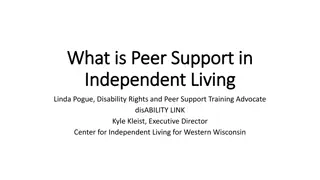Preventing Peer-to-Peer Sexual Abuse in Organizations
Learn how to identify, prevent, and respond to peer-to-peer sexual abuse within your organization. Understand what peer abuse entails, recognize warning signs, and address power imbalances that may lead to such incidents. The content highlights the reality of peer-to-peer abuse, debunks common misconceptions, and emphasizes the importance of taking preventive measures to protect minors from harm.
Download Presentation

Please find below an Image/Link to download the presentation.
The content on the website is provided AS IS for your information and personal use only. It may not be sold, licensed, or shared on other websites without obtaining consent from the author.If you encounter any issues during the download, it is possible that the publisher has removed the file from their server.
You are allowed to download the files provided on this website for personal or commercial use, subject to the condition that they are used lawfully. All files are the property of their respective owners.
The content on the website is provided AS IS for your information and personal use only. It may not be sold, licensed, or shared on other websites without obtaining consent from the author.
E N D
Presentation Transcript
Preventing Peer Preventing Peer- -to Sexual Abuse at Your Sexual Abuse at Your Organization Organization to- -Peer Peer
What You Will Learn What You Will Learn Where and how does it happen? How can I prevent it? How should I respond to it?
What is peer What is peer- -to to- -peer abuse? peer abuse? Sexual activity Inappropriate touching Pornography Sexting Sexualized language Even experimentation
The Assumption The Reality All abusers are adults P2P abuse just as common All are seasoned predators Often starts with bullying We can keep them out Doesn t have to involve touch Assume it is happening now "It can t happen here"
Minors Minors cannot consent cannot consent to sexual activity. sexual activity. to
How does it happen? How does it happen? Same or different ages Same or different sexes Bullying Coercive behavior Power imbalances
Its It s not just about sex acts not just about sex acts. . It s often an It s often an extension of extension of bullying bullying. .
The Assumption The Reality Only problem youth abuse 60% of Redwoods abuse incidents are peer-to-peer We should only worry about severe cases 74% involve similar ages (+/- 1 yr) It s rare and unlikely Incidents are under-reported
Peer Peer- -to happened happened or to- -peer peer abuse has abuse has or is happening is happening. .
Example #1: Unsupervised Bathroom Three boys, ranging from 5 to 12 On bathroom break, one boy on lookout Oldest boy forced youngest to perform oral sex act
Example #2: Teens Sneak Off Two teens asked to use bathroom Instead, snuck into back room Performed oral sex on each other Later, one disclosed that it was rape
Example #3: Playing Fort Two girls (under 10) made fort in childcare room One took photos of other s genitals Allegedly digitally penetrated victim
The Assumption The Reality Requires complete privacy Even small lapses in supervision are dangerous If staff or cameras are present we are safe Youth are good at not being detected I would see it and stop it It can even happen in full view
Where and when does it happen? Where and when does it happen? Private locations: Bathrooms, locker rooms, cabins Obstructions: Playground structures, closets, bus seats, underwater Transition times: Transportation, sign-in/sign-out, beginning/end of day
Nowhere is safe Nowhere is safe Any obstruction creates privacy Towels, bus seats, furniture all create risk Abuse happens on camera Abuse happens w/ staff present
We can create a We can create a safe environment environment where abuse where abuse cannot happen. cannot happen. safe
Engage Actively With Youth Engage Actively With Youth Know your youth Be curious, ask them how they are Participate in activities don t just watch Pay attention to changes in demeanor
Prevent Risky Situations Prevent Risky Situations Be aware of personality types or conflict Plan groups to avoid power imbalance Follow supervision protocols Do not allow alone time Model healthy behaviors (e.g. no teasing, favoritism or bad language)
Identify Red Identify Red- -Flag Behaviors Flag Behaviors Physical aggression or bullying Sexualized language or behavior Inappropriate touch Youth sneaking off/seeking privacy
Stop Conflict Before it Escalates Stop Conflict Before it Escalates Separate youth in conflict Address teasing before it becomes bullying Actively follow up with victims Report concerns to supervisors
When we are When we are ready respond respond, we become a , we become a lifeline for youth lifeline for youth. . ready to to
How do you respond to abuse? How do you respond to abuse? Separate youth Say: I believe you. I will help you. It s not your fault. Report to your supervisor immediately Follow mandated reporter laws
We must have We must have zero tolerance tolerance for abuse. zero for abuse.























